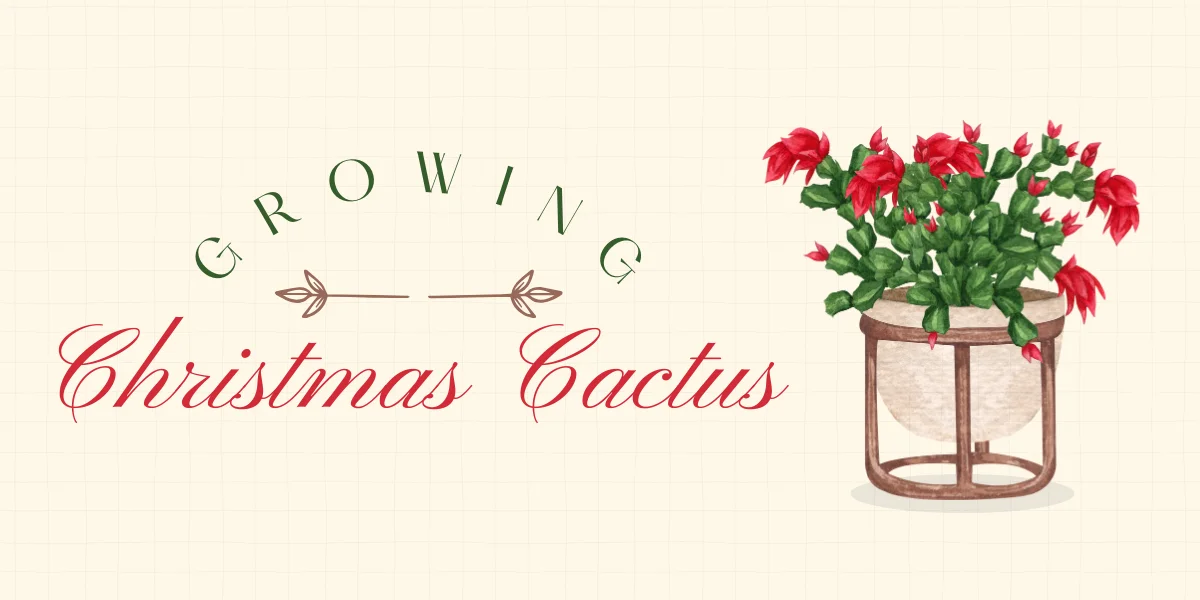Christmas cactus (Schlumbergerera x buckleyi) originated in the jungles of Brazil, where it grows on tree branches. Although happy on trees, it’s equally content in pots.
It looks glorious in hanging baskets or footed pots, where its graceful branching habit is best displayed.
It typically blooms from late November to early January, which aligns perfectly with the holiday season.
This is when the Christmas cactus is the happiest of all, and why it earned its festive name.
The blossoms, which range from white to shades of pink, red, and purple, offer a brilliant contrast to the dreary winter landscape.
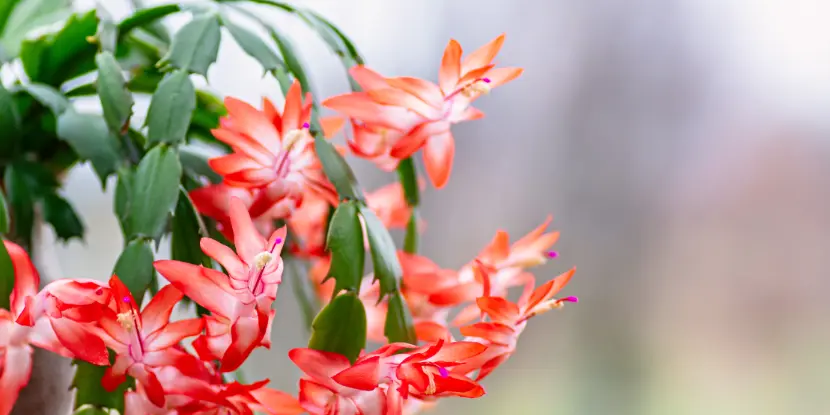
The striking red, pink, and white flowers of a Christmas cactus.
As a bonus, the Christmas cactus is relatively easy to care for, making it a favorite among indoor gardeners.
Light
Christmas cactus needs bright, indirect light, so a window with an eastern exposure is ideal.
- An ideal location near an east-facing window provides the right balance of light without exposing the plant to harsh, direct sunlight.
- Direct sunlight, especially during the peak hours of the day, can damage the plant. If placed in a south or west-facing window, use sheer curtains to diffuse the sunlight.
- Keep the cactus in a location where it receives consistent light exposure throughout the day. Avoid moving the plant frequently.
- During the shorter days of winter, supplement natural light with artificial grow lights. Place the lights a few feet above the plant and turn them 10 to 12 hours daily to mimic natural daylight.
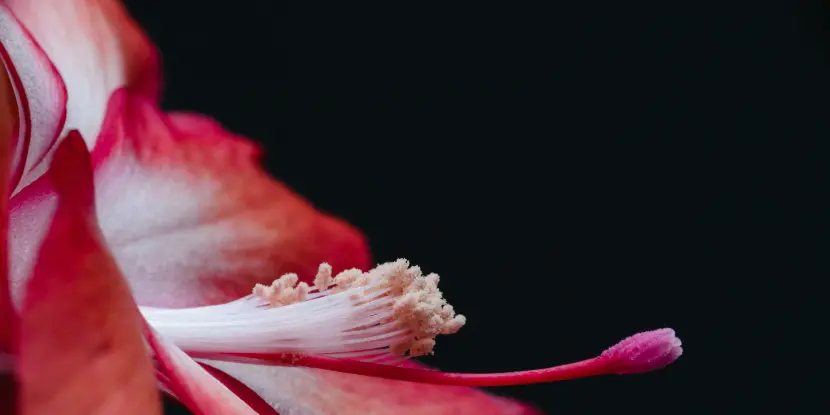
Close-up of a delicate Christmas cactus flower.
Temperature & Humidity
- For optimal growth and blooming, keep the temperature between 60°F and 70°F (15°C and 21°C) during the day.
- A slight drop in temperature at night, around 50°F to 60°F (10°C to 15°C), encourages bud formation.
- Protect the plant from temperatures above 90°F (32°C) or below 50°F (10°C), which can inhibit blooming.
- Maintain a stable temperature environment. Avoid placing your Christmas cactus near heaters, vents, drafty windows, or doorways.
- Christmas cactus thrives in moderate to high humidity. Place a humidifier or tray of water near the plant to increase air moisture.
Soil
- Use well-draining, aerated soil to prevent waterlogging.
- A cactus or succulent potting mix is ideal. It’s often composed of potting soil, sand, and perlite or pumice to enhance drainage.
- Ensure the soil is slightly acidic to neutral, with a pH between 5.5 and 6.5.
- Incorporate organic matter, such as compost or peat moss, to retain moisture while allowing excess water to flow through.
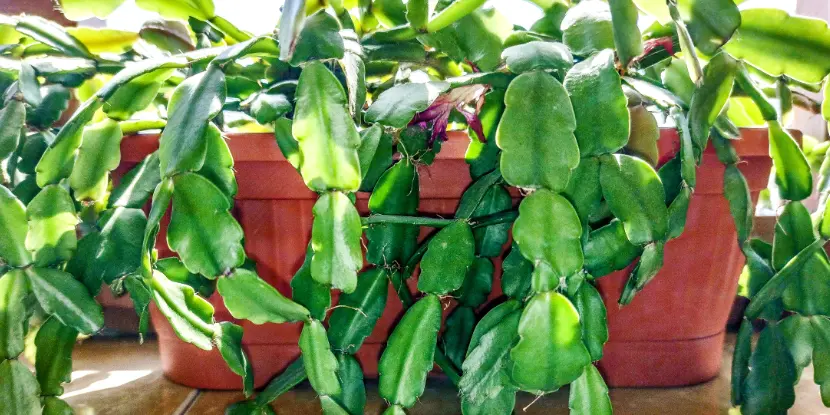
The training habit of a Christmas cactus.
Repotting
- Repot your Christmas cactus every 2 to 3 years to replenish the soil and provide room for growth.
- The best time to repot is in the spring after the blooming period has ended.
- Choose a pot slightly larger than the current one. Avoid excessive soil, which can hold too much moisture.
- Ensure the new pot has drainage holes to allow excess water to escape.
- Handle the roots gently while repotting, trimming any that are damaged or overgrown.
Fertilizing
- Spring to Early Fall: Fertilize the Christmas cactus monthly with a balanced, water-soluble fertilizer, such as 10-10-10 or 20-20-20. Dilute the fertilizer to half the recommended strength to avoid over-fertilizing, which can harm the plant.
- Late Fall to Winter: Reduce fertilizing frequency to once every two months and use a fertilizer with less nitrogen to encourage blooming. A formula like 0-10-10 is ideal during this period.
- After Blooming: Once the blooming cycle ends, resume monthly fertilizing with a balanced, half-strength fertilizer to support new growth.
- General Tips: Always water the plant before applying fertilizer to prevent root burn. Avoid fertilizing if the plant is under stress, such as during extreme temperatures or immediate repotting. Flush the soil occasionally to prevent salt buildup from fertilizers.
Controlling Pests & Diseases
Christmas cacti aren’t prone to pests or diseases, but like all houseplants, they aren’t immune.
- Pests: Common pests include mealybugs, scale insects, and spider mites. Inspect the plant for any signs of infestation, such as sticky residue on leaves, discolored or curled foliage, or visible bugs. If found, treat the plant with insecticidal soap or neem oil, following the product instructions.
- Diseases: Overwatering and poor air circulation can lead to root rot. To prevent this, ensure proper drainage and avoid over-watering. If you suspect root rot, repot the plant in fresh soil and trim away damaged roots.
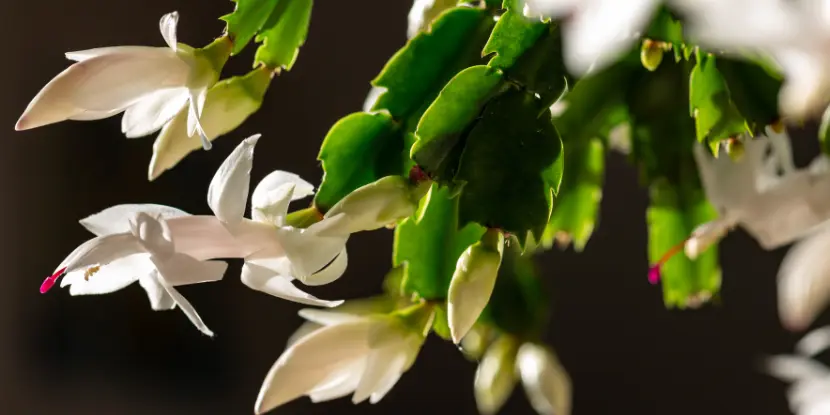
White Christmas cactus blossoms.
Pruning & Rooting Christmas Cactus
Pruning your Christmas cactus helps maintain its shape and encourages more prolific blooming. Additionally, the cuttings from pruning can be rooted to propagate new plants.
Pruning
- The best time to prune your Christmas cactus is shortly after its blooming period, typically in late winter or early spring.
- Use a sterile, sharp knife or pruning shears to avoid damaging the plant or spreading disease.
- Gently twist or cut off sections at the joint between segments. Aim to prune about one-third of the plant to encourage fuller growth and more blooms.
- Remove weak or leggy growth to maintain a compact shape.
- Allow the cut areas to heal and callus for a few days to prevent rot or infection.
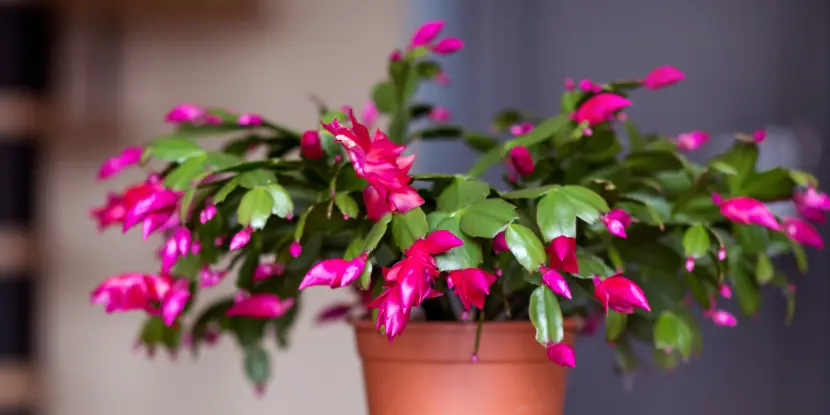
A nicely-shaped Christmas cactus plant.
Rooting Cuttings
- Choose healthy segments free of disease or pests. Ideally, select two- to five-segment lengths for rooting.
- Allow the cut ends to callus over for a couple of days. This helps prevent rotting once planted.
- Fill a small pot with a well-draining cactus or succulent potting mix.
- Insert the cut end of each segment about an inch into the soil.
- Firm the soil around the base to ensure the cutting stands upright.
- Water the cuttings lightly to moisten the soil. Maintain slightly moist soil but avoid overwatering, which can cause rot.
- After initial watering, reduce frequency and allow the soil to dry out slightly between waterings.
- If you don’t wish to start new plants from cuttings, you can separate several leaf stems (with roots intact) from the mother plant and reset them in a new pot. Do this only once every 3 or 4 years.
Using Rooting Hormone
Rooting hormone can significantly enhance the success rate of propagation.
- After allowing the cut ends of the segments to callus over for a couple of days, dip the callused end into a powdered rooting hormone.
- Shake off the excess hormone to ensure a light, even coating — a thick application can inhibit root growth.
- Ensure that the rooting hormone only covers the base of the cutting where roots will form; applying it to other areas can result in unwanted growth or failure to root.
- Proceed to plant the treated cuttings in a well-draining cactus or succulent potting mix, as described earlier.
- Rooting hormone can also be beneficial when resetting entire leaf stems with roots intact, especially if the stems have experienced stress or are slow to re-establish.
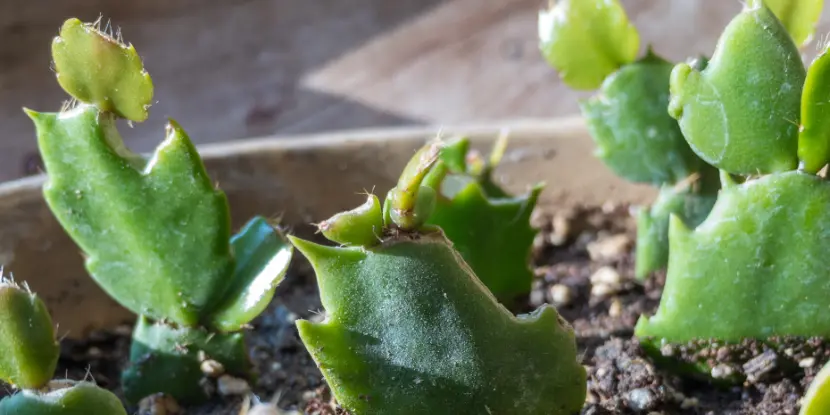
Newly divided and propagated Christmas cacti.
FAQs: Christmas Cactus Care
Q: How often should I water my Christmas cactus?
Water your Christmas cactus whenever the top inch of soil feels dry. Typically, this is about once a week, but you should adjust based on humidity and temperature conditions in your home.
Q: What kind of light does a Christmas cactus need?
Christmas cacti prefer bright, indirect light. Too much direct sunlight can burn the leaves, so place them in a spot with filtered sunlight.
Q: How can I encourage my Christmas cactus to bloom?
Ensure your Christmas cactus experiences shorter daylight hours and cooler temperatures (around 50-55°F) at night, about 6-8 weeks before you want it to bloom.
Q: When is the best time to repot a Christmas cactus?
The best time to repot a Christmas cactus is in spring after it has bloomed. Choose a pot only slightly larger than the current one, as a pot that’s too large can lead to waterlogging.
Q: What kind of soil is best for a Christmas cactus?
Use a well-draining soil mix designed for cacti and succulents. To ensure proper drainage, you can also make your own mix with one part potting soil and one part perlite or sand.
Q: Can I propagate my Christmas cactus? How?
Twist off a healthy stem segment and allow it to dry for a day before planting it in moist soil. Keep the soil lightly moist until roots develop.
Q: Why are the leaves on my Christmas cactus limp and drooping?
Limp and drooping leaves usually indicate overwatering. Ensure the pot has good drainage, and allow the top inch of soil to dry out between waterings.
Q: Can I put my Christmas cactus outside?
Yes, but acclimate it slowly to outdoor conditions in the spring and place it in a spot with filtered light. Remember to bring it back inside before temperatures drop in the fall.
Q: Why is my Christmas cactus not flowering?
Lack of flowers may be due to insufficient light during the growing season, overly warm temperatures at night, or the need for a specific photoperiod to initiate blooming. Adjust the plant’s environment to meet these needs.
Q: How do I deal with pests on my Christmas cactus?
Watch for common pests like spider mites and fungus gnats. Treat infestations with a gentle insecticidal soap or neem oil solution.

